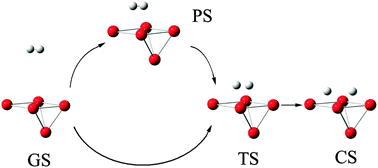The direct and precursor mediated dissociation rates of H2 on a Ni(111) surface
Abstract
The dissociation and recombination rates of physisorbed H2, and the direct and steady state dissociation (i.e., the precursor mediated dissociation) rates of gas phase H2 on Ni(111), as well as the corresponding kinetic isotope effects, are calculated using the quantum instanton method, together with path integral Monte Carlo and adaptive umbrella sampling techniques. All these rates except the recombination one first decrease and then increase with the increasing temperature, and their minimum values appear at about 250, 300 and 250 K, respectively. These non-monotonic behaviors reveal that the quantum effect of H2 should be very remarkable at low temperatures. The steady state rates are smaller than the direct rates at low temperatures, however, they become larger than the direct ones at high temperatures, these two kinds of rates become equal at about 400 and 300 K on the rigid and quantum lattices, respectively. The quantum motion of the lattice can enhance the direct and steady state rates, and it increases the steady state rate much more than the direct one, for instance, the direct and steady state rates on the quantum lattice are 1.30 and 2.08 times larger than that on the rigid one at 300 K. The calculated kinetic isotope effects are much larger than 1, which reveals that H2 always has a larger rate than that of D2, and the direct process predicts much larger kinetic isotope effects than the steady state process at low temperatures. In addition, the kinetic isotope effects are not affected by the lattice motion.


 Please wait while we load your content...
Please wait while we load your content...